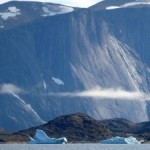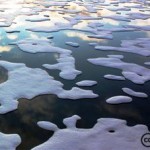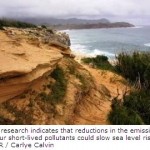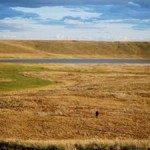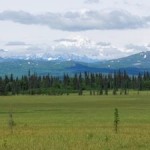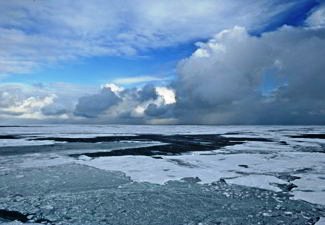 Source: University of Massachusetts Amherst
Source: University of Massachusetts Amherst
Authors: Julie Brigham-Grette, et al.
Topic Area: Climate Change, Arctic Ice Sheets
Geographic Area: Lake El’gygytgyn, Russian Arctic
AMHERST, Massachusetts, USA; COLOGNE, Germany; MAGADAN, Russia – Analyses of the longest sediment core ever collected on land in the Arctic, recently completed by an international team led by Julie Brigham-Grette of the University of Massachusetts Amherst, provide “absolutely new knowledge” of Arctic climate from 2.2 to 3.6 million years ago and show that with estimated atmospheric carbon dioxide (CO2) similar to today’s levels, the Arctic was very warm, with no ice sheets.
“While existing geologic records from the Arctic contain important hints about this time period, what we are presenting is the most continuous archive of information about past climate change from the entire Arctic borderlands. As if reading a detective novel, we can go back in time and reconstruct how the Arctic evolved with only a few pages missing here and there,” says Brigham-Grette.
These results of analyses that provide “an exceptional window into environmental dynamics” never before possible were published in Science and have “major implications for understanding the pacing and context of how the Arctic transitioned from a forested landscape without ice sheets to the ice- and snow-covered land we know today,” she adds.
Their data come from analyzing sediment cores collected in the winter of 2009 from under ice-covered Lake El’gygytgyn, the oldest deep lake in the northeast Russian Arctic. “Lake E” was formed 3.6 million years ago when a huge meteorite hit the Earth and blasted out an 11-mile (18 km) wide crater. It has been collecting sediment layers ever since. Luckily for geoscientists, it lies in one of the few Arctic areas not eroded by continental glaciers, so a thick, continuous sediment record was left remarkably undisturbed. Cores from Lake E reach back in geologic time nearly 30 times farther than Greenland ice cores that cover the past 140,000 years.
“One of our major findings is that the Arctic was very warm in the Pliocene [~ 5.3 to 2.6 million years ago] when others have suggested atmospheric CO2 was very much like levels we see today. This could tell us where we are going in the near future. In other words, the Earth system response to small changes in carbon dioxide is bigger than suggested by earlier models,” the authors state.
Also important to the story are fossil pollens extracted from the lake sediments, which allow scientists to reconstruct life around the lake in the past using modern habitat tolerances to reconstruct past winter and summer temperatures and precipitation.
Another significant finding to emerge from this first continuous, high-resolution record of the Middle Pliocene is documentation of sustained warmth with summer temperatures of about 59 to 61 degrees F [15 to 16 degrees C], about 8 degrees C warmer than today, and regional precipitation three times higher than today. “We show that this warmth well north of the Arctic Circle occurred throughout both warm and cold orbital cycles and coincides, in part with a long interval of 1.2 million years when the West Antarctic Ice sheet did not exist,” Brigham-Grette notes. Thus, both poles share some common history, but the pace of change differed.
Her co-authors, Martin Melles of the University of Cologne and Pavel Minyuk of Russia’s Northeast Interdisciplinary Scientific Research Institute, Magadan, led research teams on the project. Robert DeConto, also at UMass Amherst, led climate modelling efforts. These data were compared with ecosystem reconstructions performed by collaborators at Universities of Berlin and Cologne.
The Lake E cores provide a terrestrial perspective on the stepped pacing of several portions of the climate system through the transition from a warm, forested Arctic to the first occurrence of land ice, Brigham-Grette says, and the eventual onset of major glacial/interglacial cycles. “It’s very impressive that summer temperatures during warm intervals even as late as 2.2 million years ago were always warmer than in our pre-industrial reconstructions.”
Minyuk notes that they also observed a major drop in Arctic precipitation at around the same time large Northern Hemispheric ice sheets first expanded and ocean conditions changed in the North Pacific. This has major implications for understanding what drove the onset of the ice ages.
The sediment core also reveals that even during the first major “cold snap” to show up in the record 3.3 million years ago, temperatures in the western Arctic were similar to recent averages of the past 12,000 years. “Most importantly, conditions were not ‘glacial’, raising new questions as to the timing of the first appearance of ice sheets in the Northern Hemisphere,” the authors add.
The paper is the second published in Science by these authors using data from the Lake E project. In 2012, they covered the period from the present to 2.8 million years ago. Melles says, “This latest paper completes our goal of providing an overview of new knowledge of the evolution of Arctic change across the western borderlands back to 3.6 million years and places this record into a global context with comparisons to records in the Pacific, the Atlantic and Antarctica.”
Finally, the new Lake E paleoclimate reconstructions and climate modelling are consistent with estimates made by other research groups that support the idea that Earth’s climate sensitivity to CO2 may well be higher than suggested by the 2007 report of the Intergovernmental Panel on Climate Change (IPCC).
The international Lake El’gygytgyn Drilling Project was funded by the International Continental Drilling Program (ICDP), the U.S. National Science Foundation’s Division of Earth Sciences and Office of Polar Programs, Germany’s Federal Ministry for Education and Research, Alfred Wegener Institute, GeoForschungsZentrum-Potsdam, the Russian Academy of Sciences Far East Branch, the Russian Foundation for Basic Research and the Austrian Ministry for Science and Research.
Details of the Study:
Title of the Study: “Pliocene Warmth, Polar Amplification, and Stepped Pleistocene Cooling Recorded in NE Arctic Russia”
Authors: Julie Brigham-Grette, Martin Melles, Pavel Minyuk, Andrei Andreev, Pavel Tarasov, Robert DeConto, Sebastian Koenig, Norbert Nowaczyk, Volker Wennrich, Peter Rosén, Eeva Haltia, Tim Cook, Catalina Gebhardt, Carsten Meyer-Jacob, Jeff Snyder and Ulrike Herzschuh
Published online in Science on May 9, 2013; DOI: 10.1126/science.1233137
Check the following link to read/download the Full Study:
http://www.sciencemag.org/content/early/2013/05/22/science.1233137.abstract
Source: University of Massachusetts Amherst.

